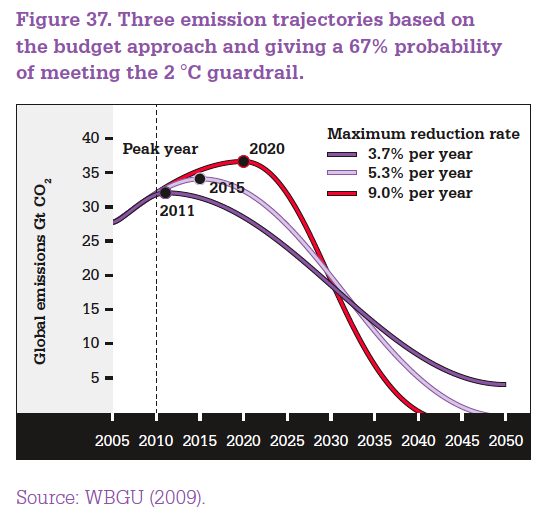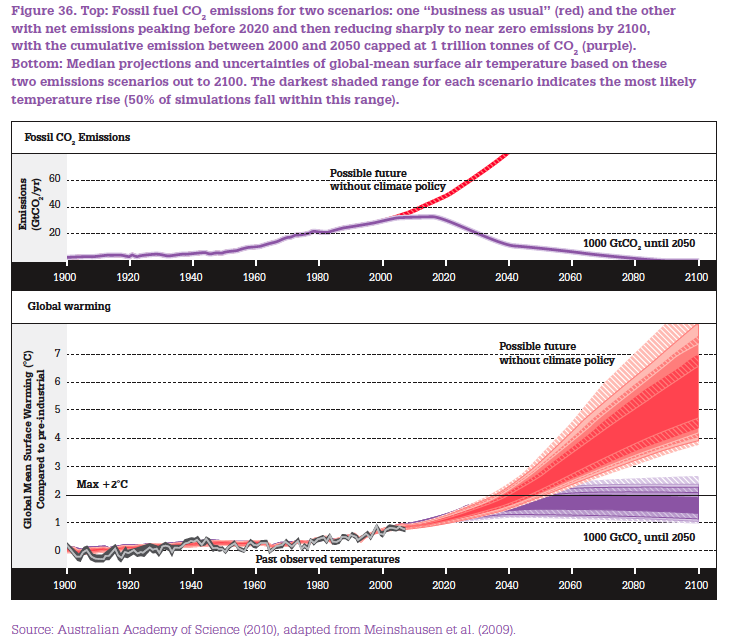The Critical Decade - Part 3: Implications for Emissions Reductions
Posted on 11 June 2011 by dana1981
The Australian government established a Climate Commission which recently released a three chapter report entitled The Critical Decade. In Part 1, we examined Chapter 1 of the report, which summarizes the current state of climate science observational data. In Part 2, we examined Chapter 2, which discussed the risks associated with a changing climate. In Part 3, we will examine Chapter 3, which looks at the implications of the science on carbon emissions reductions. The quotes and bullets below come directly from the report, while the remainder is our commentary.
The Budget Approach
Because of the long atmospheric lifetime of carbon dioxide (CO2), the total amount of carbon emitted matters more than when it is emitted. Thus the report recommends examining the issue by using a budget approach, wherein a certain budget of CO2 emissions corresponds to a certain amount of eventual global warming.
- The budget approach directly links the projected rise in temperature to the aggregated global emissions in Gt CO2 or Gt C for a specified period, usually 2000 to 2050 or 2100. For example, humanity can emit not more than 1 trillion tonnes of CO2 between 2000 and 2050 to have a probability of about 75% of limiting temperature rise to 2°C or less.
- Given an overall carbon budget between 2000 and 2050, the approach does not stipulate any particular trajectory, so long as the overall budget is respected. This allows a strategy that delivers least cost to the economy over time in making the transition to a low- or no-carbon economy.
According to the latest data, between 2000 and 2010 we emitted approximately 300 billion tons (gigatons, or Gt) CO2, so after 20% of the allotted timeframe, we're already over 30% of the way through the allotted emissions. Not a good start. However, although we're running out of time to reduce our emissions, the good news is that we're not out of time yet.
Once nice aspect of the budget approach is that as long as we're still below the allotted emissions, we still have a chance to achieve the budgetary goal. The figure below, taken from the report, shows that if we implement serious carbon emissions reductions policies soon and achieve a global emissions peak by about 2020, we can realistically meet the 1 trillion ton emissions budget by 2050. However, in a scenario without serious carbon reduction policies in place, we're looking at a potentially catastrophic warming of 4°C or more by 2100.
Implications for Emissions Reductions Trajectories
The report proceeds to discuss the fact that since we have already burned through over 30% of our allotted emissions by 2050, we're running out of wiggle room and need to act immediately.
- Reducing emissions of CO2 does not reduce or stabilise its concentrations in the atmosphere; it slows the rate of increase of CO2 concentration. To stabilise the concentration of CO2 requires emissions to be reduced to very near zero.
- The peaking year for emissions is very important for the rate of reduction thereafter. The decade between now and 2020 is critical.
- Targets and timetables are, in principle, less important in the budget approach, but the urgency of bending emission trajectories downwards this decade implies that more ambitious targets for 2020 are critical in preventing delays in the transition to a low- or no-carbon economy.
The chapter discusses the fact that although the budgetary approach gives us a good degree of flexibility, the longer we wait to take serious emissions reductions steps, the steeper the global carbon emissions cuts will have to be:

Eventually if we wait too long, we will reach a point where the necessary annual emissions cuts are simply beyond our political and technological capabilities. This point is fast approaching, which is why it's so critical to start implementing serious climate policy immediately.
Relationship Between Fossil and Biological Carbon Emissions and Uptake
The report goes on to discuss the nature of different types of carbon offsets. Some offsets are sold as an equivalent amount of carbon uptake by ecological systems (i.e. funding the planting of trees, which absorb a certain amount of carbon). However, the report discusses that in the long run, these ecological systems are not as effective as direct emissions reductions because they don't represent permanent sequestration, and "the offset approach, if poorly implemented, has the potential to lock in more severe climate change for the future."
- About 15-20% of net CO2 emissions globally have originated from land ecosystems, primarily from deforestation. This represents the removal of carbon from a stock in the active atmosphere-land-ocean carbon cycle. It does not introduce any additional carbon into the atmosphere-land-ocean system, but simply redistributes it.
- The combustion of fossil fuels represents the injection of additional carbon from an inert, underground stock into the active atmosphere-land-ocean cycle. This additional carbon is redistributed among the three main stocks in the active carbon cycle, thus adding to the amount of atmospheric CO2.
- Avoiding emissions by protecting ecosystem carbon stocks is a necessary part of a comprehensive approach to mitigation. Sequestering CO2 into degraded ecosystems is also an important mitigation activity because it reverses an earlier emission. However, sequestering CO2 into land ecosystems does not remove it from the active atmosphere-land-ocean cycle. Therefore, the sequestered carbon is vulnerable to human land use and management, which can rapidly deplete carbon stocks, and to major changes in environmental conditions, which can change the amount of carbon stored in the long term.
- The only way that CO2 sequestered into land ecosystems can permanently “offset” fossil fuel combustion is if the sequestered carbon is subsequently removed from the land ecosystem and stored in an inert state or in a stable geological formation, thus locked away from the active atmosphere-land-ocean cycle. Another approach to offsetting is to replace fossil fuels with biofuels.
The key message here is that the most effective way to reduce CO2 emissions is to leave fossil fuels in the ground. While reforestation is very important, using it as an excuse to reduce fossil fuel-related emissions less quickly is a mistake. We need to do both.
Summary
In short, the scientific evidence discussed in the report indicates that we need to take significant steps to reduce global carbon emissions immediately. One decade into the 21st Century, we're already one-third of the way to the carbon emissions we're allotted by mid-century if we're to be confident we can limit global warming to 2°C, and as has recently been in the news, even that level of warming may be too high. Yet instead of cutting emissions, last year saw a new record high in human CO2 emissions. We're headed in the wrong direction, and need to reverse course immediately.
I'll leave the last word for the Climate Commission, because I think they did an excellent job summarizing the state of affairs in the report's final paragraph:
"As you’ve read in this report, we know beyond reasonable doubt that the world is warming and that human emissions of greenhouse gases are the primary cause. The impacts of climate change are already being felt in Australia and around the world with less than 1 degree of warming globally. The risks of future climate change – to our economy, society and environment – are serious, and grow rapidly with each degree of further temperature rise. Minimising these risks requires rapid, deep and ongoing reductions to global greenhouse gas emissions. We must begin now if we are to decarbonise our economy and move to clean energy sources by 2050. This decade is the critical decade."































 Arguments
Arguments































[DB] Please note that posting comments here at SkS is a privilege, not a right. This privilege can be rescinded if the posting individual treats adherence to the Comments Policy as optional, rather than the mandatory condition of participating in this online forum.
Please take the time to review the policy and ensure future comments are in full compliance with it. Thanks for your understanding and compliance in this matter.